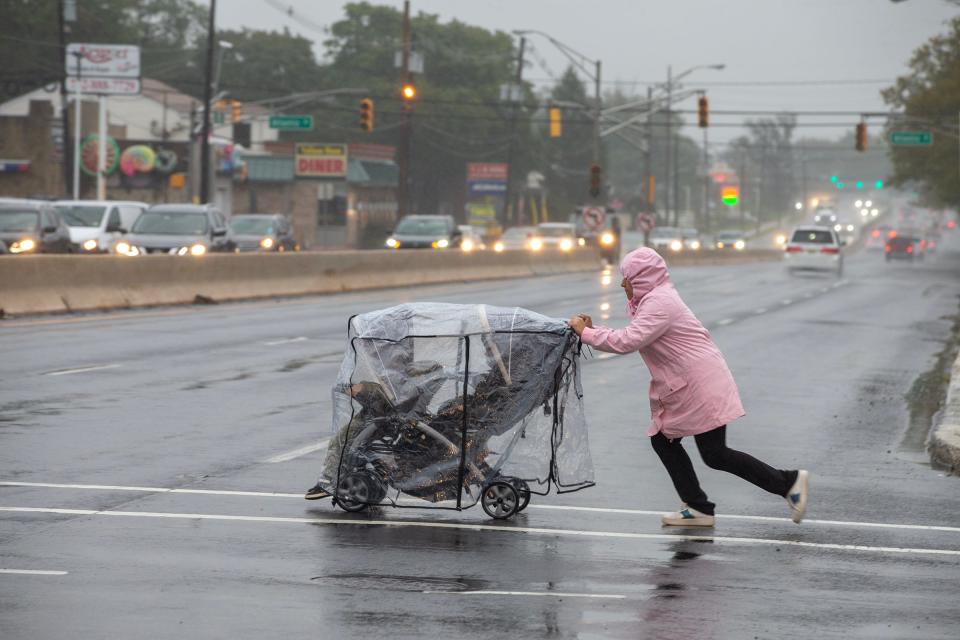Tropical Storm Ophelia passing the Jersey Shore, but 'we're still under the gun'
As the Jersey Shore unwinds from severe weather this weekend, state climatologist David Robinson warns: “We're still under the gun."
Hurricane season is still upon us.
"I think the key is: We can't let our guard down along the East Coast, in the Gulf, down in the Caribbean. We've got weeks to go before the season will fully simmer down," Robinson said.
And the power of those storms has been felt with rip currents, high waves and the impact of both on swimmers and boaters.
A 22-year-old man, Edwin Antonio Made Sanchez of the Dominican Republic, died on Labor Day weekend after he and two other swimmers were caught in a rip current in Beach Haven. Two lifeguards created a human chain to rescue the three swimmers; they pulled two ashore, but Made Sanchez slipped under the water. That same weekend, more than a dozen swimmers in Seaside Park and Belmar were rescued from rough waters.
Water recovery: Body washes ashore from Manasquan Inlet amid search for missing boater
“There's nothing to take lightly" about the devastation that can be caused by the storms, Robinson said.
While it may feel like an inundation of storms in recent years, the number of tropical systems isn't getting any heavier, said Robinson, who is also a geographer.
“We've not seen a tendency towards more tropical systems, but we've certainly not been immune to the effects of them,” he said.
Hurricane Sandy
The aftermath of monumental storms like Hurricane Sandy still linger today, as some continue to await funding to rebuild what was lost. Robinson considers it "the event" of his career as a climatologist because it had such an impact on residents' day-to-day lives.
"There are still people rebuilding from those who have waited for funds and all,” he said.
Hurricane Sandy reached Brigantine, New Jersey, on Oct. 29, 2012 as a category 2 post-tropical cyclone with hurricane force, according to the New Jersey Department of Environmental Protection. The storm surge was as high as 13 feet. All 21 counties in the state were declared major disaster areas in a declaration from President Barack Obama. The most damage was caused by flooding.
Find help for the state's hurricane survival guide at NJ.gov.
What is a tropical storm?
“A tropical system will be one that's kind of an isolated severe weather system that is surrounded by thunderstorm complexes,” Robinson said. “It generally has some kind of an eye, an interior area, and it feeds off of warm ocean waters for the most part.”

Tropical systems are more of a “renegade storm,” Robinson said, not near any cold or warm fronts that we may see with a typical winter storm. It can build up tropical characteristics with high winds. The storm must have a sustained wind, which Robinson classified as a two-minute average wind speed of 39 miles per hour or more.
What it can bring are rough surfs, heavy rains inland and the threat of a month's worth of rain in a day's time. The rain can cause the obvious overflow of small rivers and streams and flash flooding in some locations.
Take precaution when driving on roads during these floods or flash floods.
Ophelia update: Spinning off coast, leaving rain and flooding along Jersey Shore
When does hurricane season end?
Hurricane season in the Atlantic extends from June 1 to Nov. 30 while the peak of it in New Jersey lasts from early August to late October.
“I think the key is we can't let our guard down until we get well into the fall," Robinson said. "And of course, once we let our guard down in the tropical season, we have to start watching out for the coastal Nor'easters which come along.”
This article originally appeared on Asbury Park Press: Climatologist: East Coast still at risk for tropical storms

